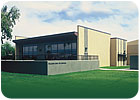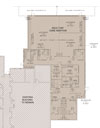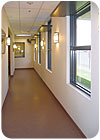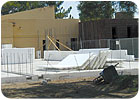
Attached to the city building in Tolleson, Ariz., is a basic, largely unremarkable and easily overlooked, add-on structure, which has put the City of Tolleson on the map of American cities with “green” buildings.
Though small in size (about 4,000 square feet with outdoor patio space) and built with limited funding, the Tolleson Adult Day Services center proves that “green” construction can be achieved affordably.
“Our client (the City of Tolleson) was committed to sustainable design,” said Ben Barcon, founder and chief executive of ADM Group, a Tempe, Ariz., architectural firm. “They had been doing a lot of brainstorming and attending a lot of workshops on sustainable design, and they would like to be a front-runner among Arizona communities.”
The city’s commitment to sustainable design is important to the story. But important for wall and ceiling contractors and their materials providers is noting that sustainable-design projects also call for their commitment–a contribution of labor perhaps, a donation of materials, anything, to pave the way to a successful project.
“No matter what anybody says, to go ‘green’ costs money,” said Barcon. “There is a premium involved.”
However, it also involves an opportunity. Contributing to the success of a municipal project such as the Tolleson Adult Day Services center fosters community goodwill and strengthens ties to architects, designers and government officials. Companies who get involved stand to reap dividends.

While the addition of the building is small, at 4,000 square feet, its “green” designation has made a dramatic impact in the local community.
Join Forces
But, how do you do it? How do you build “green” when the project has a tight budget and low square-footage, leaving little wiggle room for choosing sustainable materials that can make a difference? The answer is to look beyond the bottom line.“The client has to be willing to accept a premium markup,” said Barcon. “Some people say it’s 2 percent, others say it’s 20 percent. Whatever the markup, the client has got to say, ‘It’s important to us. We’re willing to accept the premium.’ ”
The City of Tolleson funded this project largely through a Community Development Block Grant program. ADM Group Inc. shepherded the whole process, from groundbreaking up to the start of day-to-day operations. In doing so, the firm saw a large opportunity despite its small scale.
“The square footage helped the cause of going ‘green,’” said Jennifer Bowen, LEED Accredited Professional (AP), senior designer and project manager for ADM Group. “We were able to access resources and obtain donated products. Companies were willing to use Tolleson as a showcase.”
Working closely with vendors and installers, Bowen and ADM Group turned the effort into a “donation project.”
“We tapped vendors who did not have a local project to promote their environmentally friendly products,” Bowen said.
According to Bowen, Shaw Industries donated the carpet. The ceramic tile subcontractor donated his material and labor. The Linoleum Marmorette flooring went in through a donation from Armstrong. USG Interior’s local ceilings distributor donated Donn DX Ceiling Suspension System, Mars ClimaPlus Acoustical Ceiling Panels and the installation labor.
“In some ways it was easy for the companies to donate “x”-many square feet, because it was not a big job. But I don’t think that’s the storyline here,” said Barcon. “The storyline here is that we have a client who is not only committed 100 percent to building green structures, but is committed 150 percent.”

A key sustainable design feature is access to plenty of daylight, seen here along the facility’s entrance hallway.
Pushing the Limit
Phoenix’s Foundation for Senior Living, provider of Tolleson Adult Day Services and tenant in the facility, was a key project driver. The City of Tolleson and ADM Group worked closely with the Foundation and was happy to accommodate its program needs. In leasing the building, the Foundation provides adult care and health services for up to 50 clients a day.“We tried to incorporate as many green building ideas and materials into the facility as possible,” said Christina Stoneking, Foundation for Senior Living’s coordinator for the Tolleson Adult Services project. “Being environmentally friendly is very important to the Foundation. It is very important to our work.”
For example, the project made use of ICF (insulated concrete form) wall systems from The I.C.E. Block Companies, Inc., Litchfield Park, Ariz. The Granite Block Series of I.C.E. Block used at the Tolleson project created sustainable, energy efficient (R-32) concrete walls with less construction waste than standard wall framing. The architects also incorporated windows with low-e glass, installed dual-flush toilets in the bathrooms and maximized the use of daylight–at the request of the Foundation.
“It’s one thing to say you want to incorporate daylighting, but what does that mean?” asked Barcon. “You have to find a way to put in light shelves or design the building so interior spaces get natural daylight. Then, the design has to fit an existing complex, not look totally foreign to the complex and be affordable. That’s a fine line to walk.”
The Foundation helped push the envelope, proposing configurations, advocating specific materials and staying focused on what ultimately would benefit their clients and the community.
“They wanted to provide care for any over 18 who are not physically able to care for themselves,” said Bowen. “Things such as indoor air quality were crucial to them, and so they had a lot of input.”
In addition to “green” considerations, the Foundation’s implementation of universal design principles helped to accommodate both seniors and young adults with disabilities. Such design schemes went beyond standard ADA requirements to include specialty features, such as wide hallways, low countertops, wide bathroom stalls and automatic entry doors. The efforts helped minimize barriers to movement and ensure greater safety for all ages and abilities.
In the end, the city, the architects and the Foundation all reaching for the same goals led to good choices in materials and design.
“It was good that everybody was striving for the same results, but it’s not always easy to do,” said Stoneking. “There are so many materials out there to use, and we can’t always afford to apply for LEED certification, because it’s costly and somewhat time-consuming. But, we can work together and follow guiding principles for building environmentally friendly structures.”

ICFs will add long life and extra R-value to the structure.
Great Purpose Served
So, what does the Tolleson Adult Day Services center mean to the organizations that created it?“Personally, you know that this project serves a great purpose for the community,” said Bowen. “It brings in a facility that the city did not have–an adult day care–and that enables people to be closer to home when they get support for their health and safety and well-being.”
The Tolleson Adult Day Services building opened in 2006. Officials are still completing paperwork for a possible application for LEED certification.
“It was a small project and an add-on to an existing structure at that, which means many people don’t think it’s feasible to go ‘green,’” said Bowen. “Well, it doesn’t matter–small projects can go green.”


